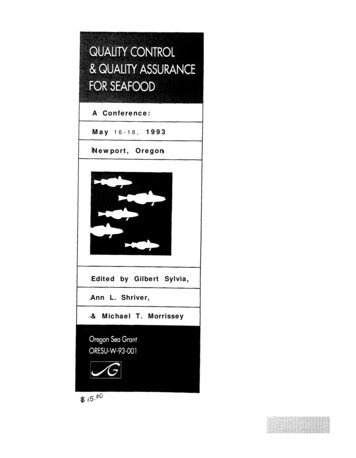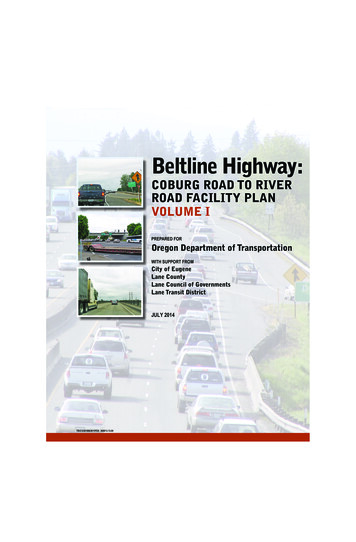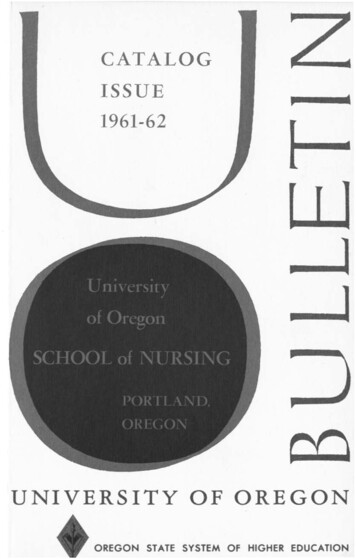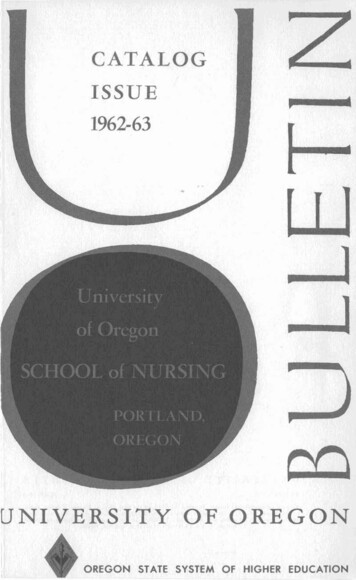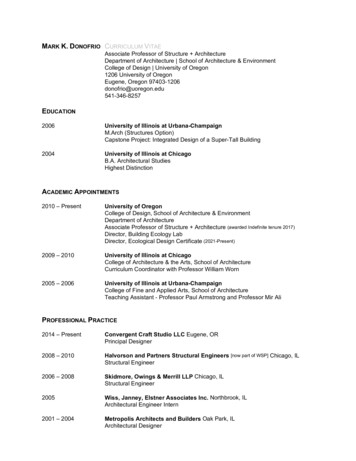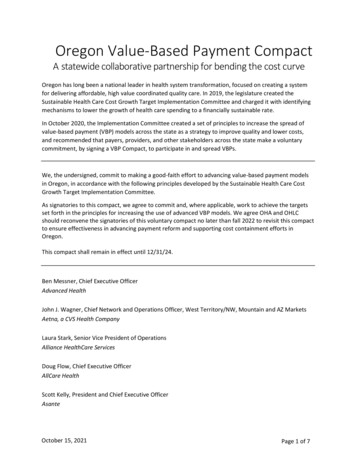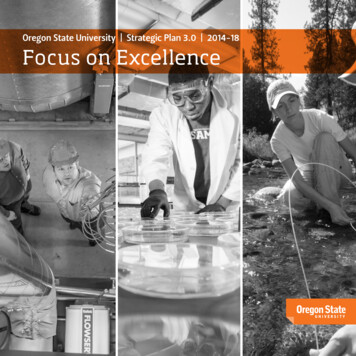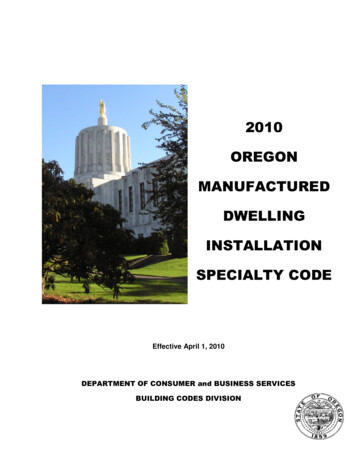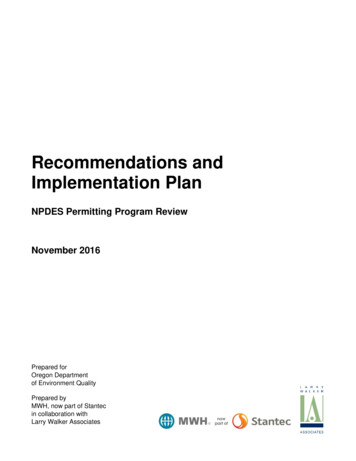
Transcription
Recommendations andImplementation PlanNPDES Permitting Program ReviewNovember 2016Prepared forOregon Departmentof Environment QualityPrepared byMWH, now part of Stantecin collaboration withLarry Walker Associates
ContentsContentsPageChapter 1Creating a New Foundation (Forward) . 1-1Chapter 2Planning Overview. 2-1Purpose. 2-1Planning Approach. 2-2Four Plan Phases . 2-2Implementation Planning Framework. 2-3Planning Topics . 2-7Multi-staged Implementation . 2-9Chapter 3Leadership (R1) . 3-1Recommendation Area 1: Leadership (R1) . 3-1R1.1 Executive Direction for NPDES Functions . 3-2Actions . 3-2Change Strategy . 3-3R1.2 Reconfiguration of Stakeholder Bodies . 3-3Actions . 3-5R1.3 Engagement of Other External Stakeholders . 3-5Actions . 3-5Change Strategy . 3-6R1.4 Communications Planning . 3-6Actions . 3-7Change Strategy . 3-7Chapter 4Community Capacity (R2) . 4-1Recommendation Area 2: Community Capacity (R2) . 4-1R2.1 Community Capacity Evaluation . 4-2Actions . 4-2Change Strategy . 4-5R2.2 Technical Assistance . 4-6Actions . 4-7Change Strategy . 4-8Chapter 5Alignment (R3) . 5-1Recommendation Area 3: Alignment (R3) . 5-1R3.1 Water Quality Standards Implementation in NPDES Permits . 5-2Recommendations and Implementation PlanNPDES Permitting Program ReviewNovember 2016 – i
ContentsActions . 5-3Change Strategy . 5-4R3.2 Water Quality Standards Process . 5-4Actions . 5-5Change Strategy . 5-6Chapter 6Efficiency and Quality (R4) . 6-1Recommendation Area 4: Efficiency and Quality (R4) . 6-1R4.1. Data Delivery Systems . 6-1Actions . 6-3Change Strategy . 6-5R4.2. Process Mapping . 6-6Actions . 6-6Change Strategy . 6-7R4.3. Permit Tools and Guidance . 6-8Actions . 6-9Change Strategy . 6-9R4.4. Five-Year Workplan. 6-10Actions . 6-11Change Strategy . 6-12R4.5. Quality Control . 6-12Chapter 7Staffing – Workload (R5) . 7-1Recommendation Area 5 – Staffing and Workload (R5). 7-1R5.1. Interim Infusion Period . 7-3Actions . 7-3Change Strategy . 7-5R5.2 Workload Assessment & Planning . 7-6Actions . 7-6Change Strategy . 7-7R5.3 Staffing Proficiency. 7-7Actions . 7-7Change Strategy . 7-8Chapter 8Funding (R6) . 8-1Recommendation Area 6: Funding (R6) . 8-1R6.1 Consistent Permit Preparation Funding Stream . 8-2Actions . 8-2Change Strategy . 8-2R6.2 Statewide Infrastructure Planning . 8-3Actions . 8-4Change Strategy . 8-4Chapter 9Progress Reporting (R7) . 9-1ii – November 2016Recommendations and Implementation PlanNPDES Permitting Program Review
ContentsRecommendation Area 7: Progress Reporting (R7) . 9-1R7.1 Progress Reporting . 9-1PDCA Cycle. 9-1Progress Report Format . 9-2Actions . 9-3Change Strategy . 9-3Sample One Page Implementation Plan Reporting Formats. 9-4Chapter 10Implementation Timeline . 10-1Action Planning Worksheets. 10-1Quick Start Tasks . 10-2Chapter 11Imperative to Act . 11-1Appendices11-1Appendix A. Internal and External Stakeholders and Points of Contact . A-1Appendix B. Partial List of Reports, Investigations and Other Relevant Documents .B-1Appendix C. Consultant Team and Peer Reviewer Biographies .C-1Appendix D. Sample Action Planning Worksheet . D-1Appendix E. NPDES Basics . E-1Appendix F. Financing and Revenue Sources . F-1Appendix G. Sample Implementation Timeframes . G-1FiguresFigure 1-1. Sharpening the Saw . 1-2Figure 2-1. 2016 Project Phases. 2-2Figure 9-1. Plan-Do-Check-Act . 9-2Figure 9-2. DEQ Quarterly Measure Review . 9-2Figure 9-3. Task Reporting (Weekly) . 9-4Figure 9-4. 4th Quarter Detail . 9-4Figure 9-5. High Level Recap of Metrics: Trends over Time . 9-4Figure F-1. The NPDES Program is One Part of an Integrated Process that IncludesWater Quality Standards and TMDL .2TablesTable 2-1. Overview of Implementation Planning Framework . 2-4Table 2-2. RACI Definitions. 2-7Table 3-1. R1.1 Change Strategy . 3-3Recommendations and Implementation PlanNPDES Permitting Program ReviewNovember 2016 – iii
ContentsTable 3-2. R1.2 and 1.3 Change Strategy . 3-6Table 3-3. R1.4 Change Strategy . 3-7Table 4-1. Recommended Features of Municipal and Industrial Wastewater TreatmentFacilities Database . 4-3Table 4-2. R2.1 Change Strategy . 4-6Table 4-3. R2.2 Change Strategy . 4-8Table 5-1. R3.1 Change Strategy . 5-4Table 5-2. R3.2 Change Strategy . 5-6Table 6-1. R4.1 Change Strategy . 6-5Table 6-2. R4.2 Change Strategy . 6-8Table 6-3. R4.3 Change Strategy . 6-10Table 6-4. R4.4 Change Strategy . 6-12Table 7-1. R5.1 – Change Strategy . 7-5Table 7-2. R5.2 Change Strategy . 7-7Table 7-3. R5.3 Change Strategy . 7-8Table 8-1. R6.1 Change Strategy . 8-2Table 8-2. R6.2 Change Strategy . 8-4Table 9-1. R7.1 Change Strategy . 9-4Table 10-1. Quick Start Activities . 10-2Table D-1. Example R5. Staffing – Workload Action Planning (Actions A5.1 to A5.3) .1Table F-1. State and Local Water Management Revenue Sources .1Table G-1. Implementation Timeframe by Recommendation Area .1Table G-2. Implementation Timeline FY 2016-2017 .5Table G-3. Implementation Timelines FY 2017-2019 .7iv – November 2016Recommendations and Implementation PlanNPDES Permitting Program Review
ContentsAbbreviations and sKPMLegislatureNPDESNPDES PermitsOregonPlanRACI ChartRPATMDLTBEL(s)WQSWQBEL(s)PWMUAATermBlue Ribbon CommitteeMWH (now a part of Stantec) and Sub consultant Larry Walker AssociatesUnited States Clean Water ActOregon Department of Environmental QualityDischarge Monitoring ReportEnvironmental Data Management SystemUnited States Environmental Protection AgencyOregon Environmental Quality CommissionFull time equivalent employeesKey Performance MeasureOregon LegislatureNational Pollutant Discharge Elimination SystemOregon’s 360 individual municipal and industrial NPDES wastewater permits.State of OregonRecommendations and Implementation PlanResponsible, Accountable, Consulted, Informed ChartReasonable Potential AnalysisTotal Maximum Daily LoadTechnology-Based Effluent LimitsWater Quality StandardWater Quality Based Effluent LimitsPermit Writers’ ManualUse Attainability AnalysisVersion ControlVersionV1DescriptionFinal ReportRecommendations and Implementation PlanNPDES Permitting Program ReviewAuthorBeutler/ GrovhougDate11/18/16November 2016 – v
ContentsThis page left blank intentionally.vi – November 2016Recommendations and Implementation PlanNPDES Permitting Program Review
Chapter 1Creating a New Foundation (Forward)Chapter 1Creating a New Foundation (Forward)For over 15 years, faced with persistent and chronic permit renewal backlogs, Oregon’sDepartment of Environmental Quality (DEQ) has pursued improvements to its National PollutantDischarge Elimination System (NPDES) permitting program. A Blue Ribbon Committee (BRC),internal work teams, an independent audit, and numerous periodic quality improvement effortshave been utilized to address the permit backlogs, which all involved consider unacceptable.Even with these significant efforts and resulting detailed recommendations, important permittinggoals still elude DEQ. At this time, Oregon’s NPDES permit backlog is considered among theworst in the nation.Oregon highly values its reputation for environmental stewardship and cherished naturalresources. Chief among Oregon’s assets are its flowing waters. Yet, by its magnitude andpersistence, the permitting backlog represents an inability to fully address the requirements of thefederal Clean Water Act (CWA). The deficiencies in implementing the CWA stand in oppositionto the State’s environmental commitments and ethics.With so many attempts at correction and so little success, some stakeholders have questioned ifDEQ’s situation is somehow unique, or perhaps might be considered a “wicked” problem.“Wicked” problems are defined as being difficult or impossible to solve because of incomplete,contradictory, and changing requirements that are often difficult to recognize.1 “Wicked”problems can never be solved, instead they must be adaptively managed with trade-offs andmitigations.After an extensive review of hundreds of documents, an evaluation of comparable situations inother states, and interviews with Oregon’s most knowledgeable stakeholders, the authors of thisRecommendations and Implementation Plan (Plan) believe the backlog problem to be complexrather than “wicked.” Complex problems are questions or issues that can be answered; however,they cannot be resolved with routine problem solving methods or linear logic. Resolutiongenerally involves applying strategies across multiple frames of reference and requiresaddressing issues at a system scale.This Plan offers recommendations, actions, and implementation approaches that address theNPDES permit renewal backlog issue at a systemic scale. It is the authors’ view thatimplementation of any single activity within the offered portfolio without addressing the fullsystem in which the backlog was created will lead to continued poor results. Althoughstakeholders may not be in full agreement with individual recommendations for action, notadopting a complex problem solving perspective will lead to continued failure to address thepermit backlog issue.1Multiple Sources: Originally attributed to Professor Horst Rittel, University of California, Berkeley.Recommendations and Implementation PlanNPDES Permitting Program ReviewNovember 2016 – 1-1
Chapter 1Creating a New Foundation (Forward)Because this Plan considers the problem at the system scale, it will also require actions by thoseoutside of DEQ’s purview. Foremost, actions are needed to provide adequate resources to theDEQ Water Program operations and for Oregon’s water infrastructure. These resources, coupledwith Oregon’s commitment to its water resources and environment, and the sincere engagementof NPDES permit stakeholders, will be required for the goals of the Plan to be achievable.Figure 1-1. Sharpening the SawPhoto Credit Isabella Conservation District, Mt. Pleasant, MIStephen Covey, a well-known leadershipexpert, tells the story of a hiker comingacross a frustrated lumberjack trying to cutdown a tree.The lumberjack was laboring in vain,swearing and cursing with eachprogressively difficult stroke.After watching for a short while, the hikersuggested the lumberjack try sharpening thesaw.The irritated lumberjack promptly respondedthat there was too much to do to stop andtake time for sharpening.Moving to a different problem solving frameworkalso requires construction of a new foundation foraction. The proposed foundation is grounded insignificant data gathering and results in a five-yearworkplan (as explained in Chapter 2, “Multi-stagedImplementation,” and Chapter 10, “ImplementationTimeline”). The authors recognize that a five-yearplan may be less than satisfying for those that havealready been waiting 15 years for resolution.However, the demonstrated lack of success usingmore expedited processes suggests that “quickerfixes” will not ultimately resolve the backlog.Figure 1-1 Sharpening the Saw, and itsaccompanying story, provides a parable on thefalse economy of action without proper resourcingand preparation. This Plan recommends actionsthat construct the foundation for success.Implementation of needed improvements will bedifficult, take time, and require commitment by allstakeholders. While the Plan places the greatestburden on DEQ, DEQ’s ultimate success willdepend on the engagement of all its stakeholders.The Plan is divided into general categories of action with associated activities. Activities may ormay not include direct linkages to one another; this is the nature of non-linear action. Chapter 10includes flowcharts that illustrate the general relationship of activities. A planning approach isalso offered which includes use of action planning sheets, change management, progressreporting and accountability measures.Complex problems are difficult but inherently solvable. This Plan outlines the necessarystrategies to achieve desired results.1-2 – November 2016Recommendations and Implementation PlanNPDES Permitting Program Review
Chapter 2Planning OverviewChapter 2Planning OverviewThe DEQ and the Oregon Legislature (Legislature) seek to maintain the chemical, physical, andbiological integrity of the State’s waters by prohibiting the discharge of any pollutant to itswaters except in compliance with the CWA,2 including section 402, which establishes theNPDES permit program. In support of this goal, through statute and regulation, the State ofOregon (Oregon) has also enacted state water quality standards (WQS).In 2015, the Oregon Legislature, concerned about a prolonged significant backlog in renewingNPDES permits, authorized DEQ to hire an outside third party to evaluate and makerecommendations for improving the NPDES permitting program. This review was to focus on360 individual municipal and industrial NPDES wastewater permits. DEQ retained MWHAmericas, Inc., now a part of Stantec, and its subcontractor Larry Walker Associates(consultants) to conduct this effort.Under the CWA, NPDES permits must be renewed every five years. The consultants focused onstrategies to achieve successful issuance and renewal of 360 NPDES permits that meet WQS,reissuance of permits every five years, and reduction in the number of administratively extendedpermits to less than 10 percent.This Plan presents a holistic planning approach to addressing the permit backlog and is pairedwith timeframes for the various activities. Focused on Oregon’s commitment to waterstewardship and compliance with the CWA, this Plan is comprised of multiple elements to beimplemented in an integrated manner. The planning horizon spans a five-year timeframe tocreate an effective and sustainable NPDES permit renewal system. Numerous previous effortshave not achieved these goals, in part because they have not addressed the full scope of thefactors affecting the NPDES program.PurposeThe purpose of this Plan is to provide detailed implementation recommendations including shortterm and long-term strategies for improvements specific to Oregon’s 360 individual municipaland industrial NPDES wastewater permits. The actions in this Plan, when implemented, areintended to achieve the following program goals: Reducing bottlenecks and roadblocks Facilitating permit compliance2The Federal Water Pollution Control Act, Amendments of 1972Recommendations and Implementation PlanNPDES Permitting Program ReviewNovember 2016 – 2-1
Chapter 2Planning Overview Assisting permit issuance planning Supporting permit quality assurance Improving resource and workload allocation Enhancing staff skills and training Achieving metrics and goals for the programThe Plan provides recommendations suitable for testing (or pilot testing) to improve and refinethe recommendations during the implementation period.For the remainder of this document the term NPDES permits or permits refers to Oregon’s 360individual municipal and industrial NPDES wastewater permits, unless otherwise specified.Planning ApproachFour Plan PhasesThis Plan is the final report of a project which was conducted during 2016 in four phases. Figure2-1 illustrates the four project phases and primary tasks of each phase.April2016 Project Launch Situation Assessment Stakeholder Input Public WorkshopMay2016Spring Summer 2016Fall2016 Using Phase 1 results,create detailed workplan for investigation ofproblem Identify additionalprogram documentationfor review Conduct investigation Preparerecommendations Identify options/describe trade offs Conduct peer review Stakeholder input Public Workshop Revise, as needed PrepareImplementation Plan Stakeholder input Public Workshop Revise as needed Release Final ReportFigure 2-1. 2016 Project PhasesThe first project phase involved conducting a Situation Assessment that included interviews withnearly 40 highly knowledgeable stakeholders3 with an in-depth understanding of the NPDES3The initial round of interviews included 39 participants; 30 additional stakeholders and experts on topics covered inthis Implementation Plan were consulted in the preparation of subsequent project phases.2-2 – November 2016Recommendations and Implementation PlanNPDES Permitting Program Review
Chapter 2Planning Overviewpermitting process. A list of stakeholders consulted during the project is provided in AppendixA. The Situation Assessment also included an initial review of multiple documents related toprevious program reviews. Information gathered during this first phase was used to identify anddefine problems, develop findings, and outline an initial framework for improvements. Thisphase also included a public workshop on May 6, 2016, where interview participants wereinvited to augment or clarify Situation Assessment results.During the Situation Assessment, the consultants confirmed that, during more than 15 years ofreviews, multiple investigators have offered numerous well-considered recommendations.However, it appears that many of the recommendations were not implemented, and, for thosethat were, the underlying causes driving backlog remained. Because of this, with one exception,improvement efforts were not able to achieve substantial or long-term results.Phase 2 of the project involved working with DEQ staff to outline specific project activities andincluded a review of additional documents and reference materials. The consultants consideredover 100 documents in preparing this Plan. A list of key documents is contained in Appendix B.During Phase 3 of the project, program review findings and recommendations were developedusing the information and stakeholder feedback obtained during the previous project phases. Inpreparing the final recommendations, the consultants sought to refine the vision for programsuccess, identify options for improvements, develop findings and suggested actions, and toevaluate the benefits and disadvantages of implementing the recommendations (as compared tono action).A draft of these findings and recommendations were submitted to an expert peer review panelcomprised of Geoffrey Grubbs, James Hanlon, and Frederick Andes. More information about theconsultant team and peer reviewers is provided in Appendix C. The peer reviewers eachindependently reviewed the findings and recommendations. Then the peer reviewers participatedin a workshop with the consultants and other peer reviewers to allow individual reviewers tohave an opportunity to discuss their observations with the others.During Phase 4 of the project, a final draft of findings and recommendations were shared withstakeholders i
Plan Recommendations and Implementation Plan RACI Chart Responsible, Accountable, Consulted, Informed Chart RPA Reasonable Potential Analysis TMDL Total Maximum Daily Load TBEL(s) Technology-Based Effluent Limits WQS Water Quality Standard WQBEL(s) Water Quality Based Effluent Limits PWM Permit Writers' Manual
